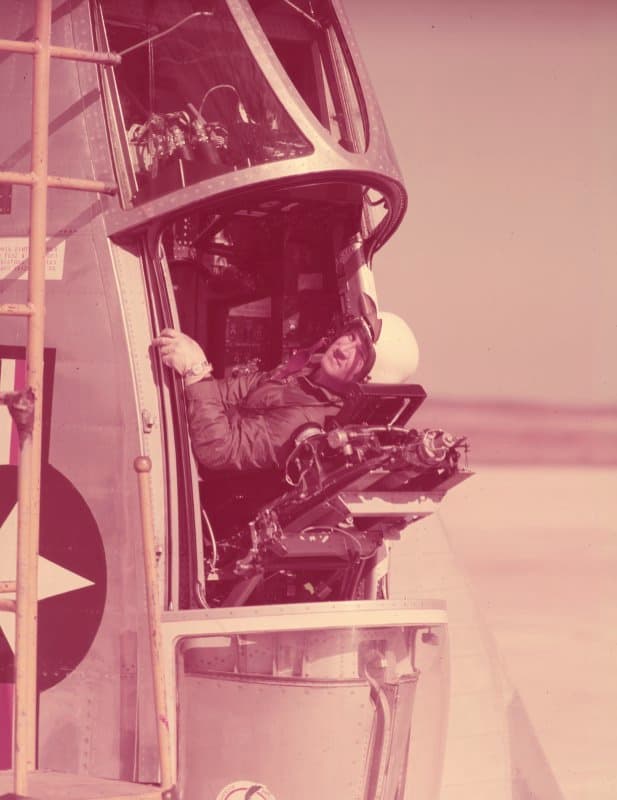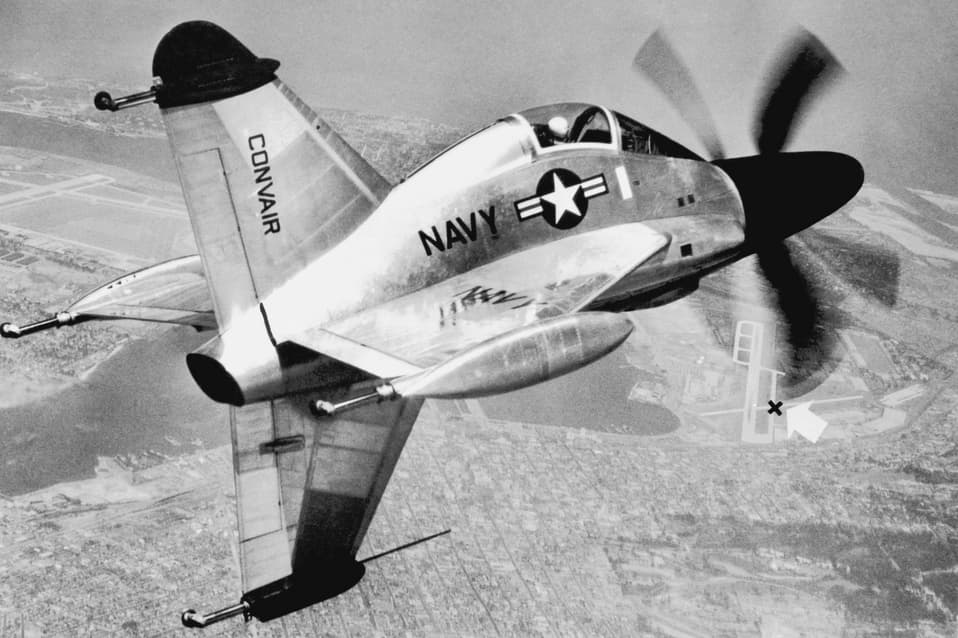- Yes
- No

Hello everybody. I’d like to introduce and suggest the Convair XFY-1 Pogo for the US Aviation tech tree in War Thunder. This experimental “tailsitter” prototype, developed by Convair in the early 1950s, was designed to explore the feasibility of shipborne VTOL fighters capable of operating from confined deck spaces on conventional ships, a capability beyond what contemporary helicopters could offer for convoy defense.
History
BackgroundIn 1947, both the US Air Force and Navy initiated VTOL design studies under Project Hummingbird to assess the potential role of vertical takeoff and landing aircraft in future conflicts. The Air Force emphasized the need for VTOL fighters, concerned that Soviet attacks could rapidly overwhelm conventional airfields. Simultaneously, the Navy, drawing from its combat experience against Japanese kamikaze attacks, sought to equip all ships, from destroyers to transports, with VTOL fighters for self-defense in hostile waters.
By 1948, the Navy expanded these studies, incorporating insights from captured German documents about the Focke-Wulf Triebflügel, an innovative tailsitter VTOL ramjet fighter concept. The resulting requirements called for fighters that could be stored vertically in shipboard “tepee” structures, ready for immediate launch to intercept threats until carrier-based reinforcements arrived.
On May 31, 1951, the Navy awarded contracts to Convair and Lockheed to develop practical VTOL fighters, designated XFY-1 and XFV-1, respectively. Both were “tailsitters,” designed to stand vertically during takeoff and landing. They were powered by the experimental Allison XT40 turboprop engine, which combined two T38 engines through a single gearbox to drive counter-rotating propellers, a configuration also used in the Douglas XA2D-1 Skyshark and Convair R3Y Tradewind. The XT40 delivered an exceptional thrust-to-weight ratio exceeding 1:1, enabling true hover and vertical flight. Both designs were intended to use the more powerful Allison T54, though this engine never materialized for the program.
Convair XFY-1 Design FeaturesThe XFY-1 incorporated several innovative design features. It used conventional propulsion with equal-span tailfins mounted both ventrally and dorsally, with small castor wheels on all four wingtips for ground maneuvering. The cockpit was elevated to improve pilot visibility over the nose during vertical operations. The planned armament configuration included either two or four 20mm guns or forty-eight folding-fin rockets in wingtip pods, though these weapons were never actually installed. One of the most significant innovations was the rotating reclining pilot seat, which tilted up to 45 degrees during transitions between flight modes to maintain pilot comfort and situational awareness. The ventral tailfin was designed to be jettisonable for emergency landings. Unlike the Lockheed XFV-1, the XFY-1 featured modified delta wings with a 52-degree sweep for improved stability.
Flight Testing ProgramIn March 1951, the US Navy ordered two prototypes from Convair, but only one prototype was completed with serial number 138649, which was selected for the flight tests. Convair took a different approach to testing than Lockheed, opting to evaluate the XFY-1 in full VTOL mode from the outset rather than using temporary landing gear. This decision meant Convair received the only suitable vertical-running Allison YT40 engine, while Lockheed’s XFV-1 had to make do with a non-vertical variant.
The flight test program began in December 1953 with VTOL engine testing on a specialized vertical test rig at Lindbergh Field, California. This rig consisted of the engine, propellers, and an abbreviated forward fuselage including the cockpit, all mounted on four legs. By February 1954, the engine was running smoothly without any technical issues. The airframe was then shipped to NAS Moffett Field for tethered flight tests, officially called vertical taxi trials. On April 29, 1954, the XFY-1 completed its first tethered flight, followed by hundreds of takeoffs and landings in this configuration.
By August 1954, testing progressed to outdoor free hover tests. The first attempt achieved just 20 feet of altitude, but subsequent attempts reached 150 feet, marking a significant feat as the first time a propeller-driven aircraft of its size had achieved vertical takeoff and landing. This demonstrated the XFY-1’s unique capabilities compared to the Lockheed XFY-1, which never had the opportunity to conduct full VTOL operations.
On November 2, 1954, the XFY-1 made its first transition to horizontal flight, spending 21 of the flight’s 28 minutes in horizontal mode. Two days later, on November 4, it successfully completed multiple transitions between vertical and horizontal flight, with the maneuvers documented by an AD-5 chase plane. By February 5, 1955, the aircraft reached 10,000 feet for the first time.
On May 19, 1955, the XFY-1 encountered a near-disastrous incident during vertical flight testing at Lindbergh Field when attempted without proper rig training, resulting in a hard landing that prematurely terminated the flight. This incident led to the establishment of a dedicated tether rig at NAAS Brown Field specifically for pilot training purposes. The aircraft’s final free flight occurred on June 16, 1955, marking both its longest and last untethered operation. Subsequently, testing was limited to tethered training exercises, which resumed on May 8, 1956, and continued for 32 days until the program’s ultimate termination on August 1, 1956.
By this time, it revealed that the YT40’s gearbox was producing metal particulates, necessitating complete replacement and leading to the indefinite suspension of all XFY-1 flight operations, as the government stopped funding the XFV-1 program, effectively canceling the project.
Program Termination and LegacyDespite its technical achievements, the XFY-1 program was later met with doubts that led to its cancellation. The aircraft required exceptionally skilled pilots to operate, making widespread deployment impractical. Furthermore, the naval aviation landscape had transformed dramatically with the introduction of conventional aircraft capable of Mach 2 performance, while persistent carrier operation challenges with jet aircraft had been largely resolved, rendering the subsonic turboprop VTOL concept obsolete. The final blow came when the promised Allison T54 engine failed to materialize.
The program officially ended on August 1, 1956, but its legacy endured through technological contributions to subsequent aircraft. Lessons learned from the YT40 engine development directly benefited turboprop systems used in the C-130, P-3, and Convair 580. Today, one surviving XFY-1 is preserved at the National Air and Space Museum in Suitland, Maryland.
Specifications
Convair XFY-1 PogoGeneral Characteristics
- Crew: 1 (Pilot)
- Length: 35 ft (10.67 m)
- Wingspan: 27 ft 8 in (8.43 m)
- Wing Area: 355 sq ft (32.98 sq m)
- Propeller:
- Type: Curtiss-Wright turbo-electric six-bladed contra-rotating
- Diameter: 16 ft (4.88 m)
- Powerplant: 1 × Allison XT40-A-16 turboprop
- Takeoff: 6,825 shp (5,020 kW) @ 15,700 RPM
- Military: 6,955 shp (5,115 kW) @ 14,300 RPM
- Normal: 5,775 shp (4,250 kW) @ 14,300 RPM
- Fuel Capacity: 576 US gal (2,180 L)
- Oil Capacity: 12 US gal (45.4 L)
- Weights:
- Empty: 11,742 lb (5,326 kg)
- Combat: 14,012 lb (6,356 kg)
- Max Takeoff: 16,250 lb (7,371 kg)
Performance (Estimates with YT40-A-16 engine @ Combat Weight)
- Max Speed:
- Sea Level: 582 mph (937 km/h)
- At Altitude:
- 610 mph (982 km/h) @ 15,000 ft (4,572 m)
- 595 mph (958 km/h) @ 35,000 ft (10,668 m)
- Wing Loading: 39.5 lb/sq ft (193 kg/sq m)
- Rate of Climb: 11,500 ft/min (58 m/s)
- Time to Altitude:
- 20,000 ft (6,096 m): 2.7 minutes
- 30,000 ft (9,144 m): 4.6 minutes
- Service Ceiling: 44,000 ft (13,411 m)
Armament
- Armament:
- 4 x 20 mm Colt Mk. 12 Mod. 0 cannons (150 rounds per gun; 600 total) mounted in wingtip pods
OR- 48 x 70 mm rockets in wingtip pods
SAC Data





Diagrams





Cockpit


Images



















- Naval Fighters Number 27 - Convair XFY-1 - VTOL Fighter (1994)
- Standard Aircraft Characteristics XFY-1 (1 September 1952)
- Convair XFY Pogo - Wikipedia
- Convair XFY-1 Pogo | National Air and Space Museum
- CONVAIR XFY Pogo Experimental Vertical Take-Off and Landing (VTOL) Fighter Prototype
- Convair Pogo | Aircraft |